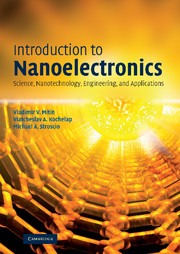Book contents
- Frontmatter
- Contents
- Preface
- List of notation
- 1 Toward the nanoscale
- 2 Particles and waves
- 3 Wave mechanics
- 4 Materials for nanoelectronics
- 5 Growth, fabrication, and measurement techniques for nanostructures
- 6 Electron transport in semiconductors and nanostructures
- 7 Electrons in traditional low-dimensional structures
- 8 Nanostructure devices
- Appendix: tables of units
- Index
4 - Materials for nanoelectronics
Published online by Cambridge University Press: 05 June 2012
- Frontmatter
- Contents
- Preface
- List of notation
- 1 Toward the nanoscale
- 2 Particles and waves
- 3 Wave mechanics
- 4 Materials for nanoelectronics
- 5 Growth, fabrication, and measurement techniques for nanostructures
- 6 Electron transport in semiconductors and nanostructures
- 7 Electrons in traditional low-dimensional structures
- 8 Nanostructure devices
- Appendix: tables of units
- Index
Summary
Introduction
After the previous introduction to the general properties of particles and waves on the nanoscale, we shall now overview the basic materials which are exploited in nanoelectronics. As discussed in Chapter 1, electronics and optoelectronics primarily exploit the electrical and optical properties of solid-state materials. The simplest and most intuitive classification of solids distinguishes between dielectrics, i.e., non-conducting materials, and metals, i.e., good conducting materials. Semiconductors occupy a place in between these two classes: semiconductor materials are conducting and optically active materials with electrical and optical properties varying over a wide range. Semiconductors are the principal candidates for use in nanoelectronic structures because they allow great flexibility in the control of the electrical and optical properties and functions of nanoelectronic devices.
The semiconductors exploited in microelectronics are, in general, crystalline materials. Through proper regimes of growth, subsequent modifications and processing, doping by impurities, etc., one can fabricate nanostructures and nanodevices starting from these “bulk-like” materials.
Other physical objects that demonstrate promising properties for nanoelectronicswere discovered recently, for example carbon nanotubes. These wire-like and extended objects are of a few nanometers in cross-section. They can be produced with good control of their basic properties; in particular, they can be fabricated as either semiconductors or metals. Various types of processing techniques have been shown to be viable for the fabrication of electronic nanodevices from carbon nanotubes.
- Type
- Chapter
- Information
- Introduction to NanoelectronicsScience, Nanotechnology, Engineering, and Applications, pp. 65 - 108Publisher: Cambridge University PressPrint publication year: 2007



